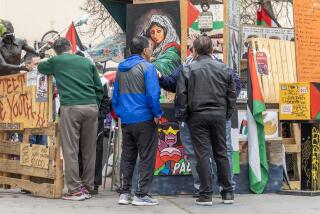In the May 4th Tradition, Chinese Students Seek a New Turning Point
- Share via
The student demonstrations that erupted last month after the death of Hu Yaobang, who had become a symbol of democracy, are very much in the Chinese tradition. The first student demonstration in modern times occurred 70 years ago today. Then, as in April, Beijing University students marched from their campus to Tian An Men Square to demonstrate against the government and demand “democracy and science.” April’s rally put less emphasis on science, which the government already supports, and more emphasis on demands for freedom of speech, rule of law, end of corruption and student-led, rather than party-led, organizations and publications.
The May 4th Movement became a turning point in Chinese history, leading to the overthrow of the warlord government and rejection of Confucian ideology, which had dominated China for more than 2,000 years. Whereas the May 4th Movement challenged Confucianism, 1989’s demonstration challenged Marxism-Leninism and the Communist Party that have dominated since 1949. Like the May 4th Movement, the April demonstration was well-organized, starting in Beijing and spreading to universities throughout China. That the students were able to conduct their protests of more than 100,000, facing off against policemen and military men without any major incident, shows the degree of organizational skill that they must have learned from their party elders, the very people they have turned against.
Like their May 4th predecessors, the students, following the demonstration, have boycotted classes and mobilized support to their cause from other groups--the middle class, workers and peasants. In modern times, student movements have only been successful when they have gained wider social support. There is evidence that members of the emerging small-scale entrepreneurial class that has been spawned by Deng Xiaoping’s economic reforms has helped the students morally and financially. Workers on fixed incomes who have been hurt by inflation, also caused by the reforms, have joined in the demonstrations, though their concerns are more economic than political.
The May 4th Movement was able to take place and expand because the warlord government was relatively weak. By contrast, China’s present government can act decisively if it wishes. It is ironic that one reason the party leaders purged Hu as the general secretary in January, 1987, was because he had refused to repress the student demonstrations for democracy in December, 1986. Yet the same leaders have showed restraint this time.
In part, the leadership is divided and uncertain about what action to take. Accelerating inflation, blatant corruption of officials and their children and the people’s general discontent have created a potentially explosive situation, which the leaders fear may erupt into chaos if they crack down. Moreover, the memory of repression and anarchy of the Cultural Revolution, in which these leaders were among the victims, also is a limiting factor. Perhaps most important, unlike the regimes of the warlords, Chiang Kai-shek and Mao Tse-tung, the Deng regime has been reluctant to use violent means to suppress political demonstrations.
Another restraint is China’s concern with its image in the outside world. During the Cultural Revolution, China did not care about its image abroad. But today it does because it wants foreign capital, technology and help with its modernization. It also cares about its image in the communist world, in which it sees itself in competition with the Soviet Union in developing the most effective model for reform. Although China has stressed economic rather than political reform, it too has accepted the need for the latter. A bloody repression of students demanding democracy at the very time Mikhail S. Gorbachev’s visit is imminent could be very embarrassing.
Both the May 4, 1919, and April, 1989, demonstrations occurred in a pluralistic intellectual atmosphere in which many ideas from abroad were vigorously and publicly debated. Many of the students’ teachers and intellectual elders had written about and openly advocated the democratic rights for which the students demonstrated. In the two months preceding the April demonstration, nearly 100 of China’s most prominent intellectuals had success makes you feel pessimistic. It condemns you to loneliness and makes you feel apart from the world. Talking so much about my films sometimes makes me depressed. I think dwelling on your organized a petition to the government demanding the release of political prisoners and democratic rights. This was the first time since 1949 that intellectuals had organized publicly for political purposes.
An important difference, however, between the two movements, is that they took place in different contexts. The May 4th occurred two years after the Russian Revolution, when it appeared that the Bolsheviks with their Marxist-Leninist ideology had found a way to modernize a backward country quickly. Its model and ideology became the inspiration for many of the participants of the May 4th Movement--among them Mao--who were to establish the Chinese Communist Party and eventually lead it to power.
The participants in the April demonstration specifically reject that model and ideology as a failure and as inappropriate. The models today are the Western democratic systems and the idea of human rights as evolved in the West. However, just as the Chinese transformed Buddhism or Marxism-Leninism brought in from abroad, whatever they take from abroad today will be combined with aspects of their own tradition and society.
This year is also the 40th anniversary of the Chinese Communist revolution. Will 1989 mark a comparable turning point in Chinese history?
More to Read
Sign up for Essential California
The most important California stories and recommendations in your inbox every morning.
You may occasionally receive promotional content from the Los Angeles Times.













